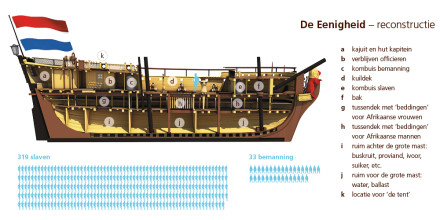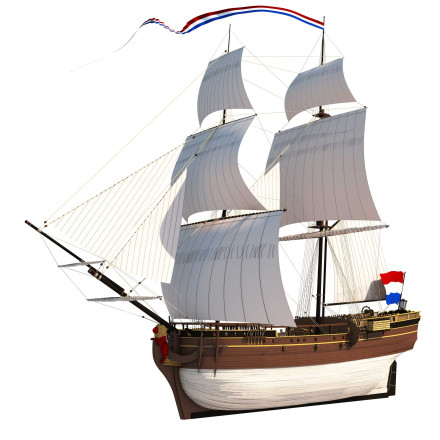History
The ship
The Eenigheid was a Dutch snow (snauw) ship, built by the Middelburgse Commercie Compagnie (MCC, a trading company from Zeeland). The construction of the vessel started in 1755, with the re-use of the keel of the Grenadier, a frigate of the MCC, and was then put on halt for a couple of years. In 1758 the vessel was launched and it was finished for its first journey in 1759.
The ship was about 80 feet long and had a tonnage of 60 ¾ last. It had two square rigged masts, with on the main mast a snowmast with trysail, which is typical for a snow ship. It was equipped with a boat and a sloop, which were carried on board during its time at sea. When reaching coastal areas the boat was put overboard and was able to be rowed or to be sailed. It had a small mast with a mainsail and a jib. For its third journey it is known the ship was carrying ten large canon and six small caliber canon. Adriaan van der Bilt constructed the figurehead of the ship, a lion, and the name on the transom of the ship.
The Vrouw Maria, found in the Baltic Sea, was also a snow ship and probably had similar characteristics. The ship, also Dutch, was refitted in 1748 and rigged as a koff. She sank in 1771.
Slave ship
When sailing as a slave ship in the triangular trade between Europe, Africa and the Caribbean, the ship was modified for the transportation of enslaved people. A partition, with door, was placed on the waist deck to prevent the slaves to enter the afterdeck. The door was permanently guarded. A wooden accommodation was also built for the enslaved women to stay in during daytime, two extra toilets for the enslaved people, an extra galley and in the tween deck an extra floor was made to fit more people.

Journeys
A total of five Atlantic voyages were made with the Eenigheid. The first two were transatlantic trade voyages from the Netherlands to Curacao and back. The last three journeys of the ship were triangular slave trade journeys from the Netherlands to western Africa to buy slaves and then sell them in the Caribbean. On the outward run, the ship's cargo consisted mainly of goods like textile, gunpowder and rifles , meant for the procurement of enslaved people, gold and ivory in Western Africa. During the third journey of the ship a total of 319 enslaved people were bought. The money earned with the sale of these people in the Caribbean was spend on sugar, coffee beans and tobacco, which was taken back to the Netherlands together with the gold and ivory bought in Africa.
After its fifth journey the Eenigheid got stuck in stormy weather on the North Sea after the pilot got lost due to the poor visibility. After seven days the ship spotted the west coast of the island of Schouwen in Zeeland on the 6th of November 1767. With a new Dutch pilot on board the ship hit the seabed several times and on the 7th of November the captain and officers decided to abandon the ship. Eventually the ship was heavily damaged by the waves and sank. The ship and its cargo could not be saved.
The Middelburgse Commercie Compagnie (MCC)
The MCC was a Dutch trading company, founded in 1720 in Middelburg, Zeeland, the Netherlands. The MCC was a smaller company than the VOC (Dutch East India Company) and WIC (Dutch West India Company), but was still active long after these two were gone. Besides trade with the Baltic Sea and the Mediterranean Sea, the MCC was active in the triangular trade in enslaved people. During its existence, a total of 296 journeys were undertaken of which a 114 were journeys to trade in enslaved people. From 1756 on the MCC was more or less specialized in this trade, until it came to an end in the early 1800's. From 1756 until 1807 a total of 92 journeys with enslaved people and 22 different journeys were undertaken. In its later years the MCC focused on ship building, until the company's ending in 1889.
The MCC's archive and the blog of the Eenigheid
The MCC has an extensive, almost complete and well-kept archive and is therefore an important source of information regarding the triangular trade. The archive was added to the UNESCO Memory of the World register in 2011. The documents of the third journey of the Eenigheid have been digitised and the daily journals of the journey were published in the form of a blog on a daily bases between 2013 and 2015.

Description
Yard: Middelburg.
Masters: 1st trip: Tobias Canisius.
2nd trip: Tobias Canisius.
3rd trip: Jan Menkenveld.
4th trip: Daniël Pruijmelaar.
5th trip: Willem de Molder.

| Length | 80 feet (24.4 m) |
|---|---|
| Tonnage | 170 ton (85 last) |